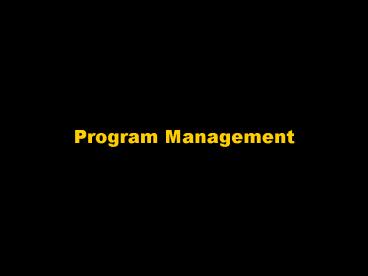Program Management - PowerPoint PPT Presentation
1 / 17
Title:
Program Management
Description:
EM Coordinator's Task. The EM program manager's task is to use a variety of resources, ... Characteristics of Effective EM Programs. Roles of officials defined. ... – PowerPoint PPT presentation
Number of Views:47
Avg rating:3.0/5.0
Title: Program Management
1
Program Management
2
Primary Reference
- Emergency Management Principles and Practices for
Healthcare Systems, The Institute for Crisis,
Disaster and Risk Management (ICDRM) at the
George Washington University (GWU) for the
Veterans Health Administration, Department of
Veterans Affairs (VA), Washington, DC, June,
2006. Available at www.va.gov/emshg
3
Lesson Objectives
- Describe the purpose and composition of an
emergency management committee. - Explain the role of the emergency program
manager. - Identify the components of a strategic
administrative plan. - Discuss various managerial strategies that are
used in emergency management program development.
4
Emergency Management Committee Purpose
- Define the role of the organization in the
community-wide emergency management program. - Responsible for the emergency management program.
- Review, approve, staff, budget and track
corrective actions. - Ensure that all employees have received
appropriate training.
5
Emergency Management Committee
- Sub-committee of the Environment of Care
Committee. - Chaired by an Associate Director.
- Membership to include all relevant key operating
units/departments. - Emergency Management/Preparedness Coordinator is
the action officer. - Task groups established to accomplish various
work products.
6
EM Coordinators Task
- The EM program managers task is to use a
variety of resources, techniques and skills to
create a team of entities who work through a
process of steps that reduces the probability and
impact of extreme events and should a disaster
occur, brings about a quick restoration of
routines.
Hoetmer
7
Dealing with Resistance
- Apathy by the General Public
- Lack of awareness
- Under-estimation of risk
- Over-reliance on technology
- Fatalism/denial
Auf der Heide
8
Organizational Apathy
- Opposing special interest groups
- Lack of an organized constituency
- Defeatism
- Higher priorities
- Difficulty substantiating the benefits
- Over-estimation of capability
- Inter-governmental paradox
- Ambiguity of responsibility
Auf der Heide
9
Types ofPlanning in Emergency Management Programs
- Strategic administrative planning
- Mitigation planning
- Preparedness planning
- Emergency Operations Planning
- Incident Action Planning (Response planning)
- Recovery planning
NFPA 1600
10
Strategic Admin. Planning
- Laws authorities
- Policy mission statement(s)
- Program Coordinator Emergency Management
Committee responsibilities - Goals, objectives, strategies budget
- The strategic plan for the EM Program,
developed by the EM Committee and approved by the
CEO
11
Why are Goals Important?
- Disasters dont happen everyday!
- Establish direction
- Help to maintain long-run involvement of resource
providers - Enhance performance
Stoffel
12
Objectives Strategies
- Objectives
- Break the goal into its parts
- Clarify what is being sought
- Allow measurement of progress
- Strategies are the means to accomplish the
desired results
13
Characteristics of Effective EM Programs
- Roles of officials defined.
- Areas of responsibility and lines of command are
clear. - Good interpersonal relationships.
- Planning is conducted on an on-going basis.
- All hazard approach.
- Motivation provided for involvement.
ICMA
14
Strategies for Success
- Meet and greet operating unit managers.
- Research the facility and community.
- Establish personal credibility and commitment.
- Use past experience.
- Engage in consensus-building activities.
- Seek to coordinate, not control.
Drabek
15
Building Support with the Committee
- Conduct regular, brief and informative updates.
- Create opportunities for external linkage.
- Ability to show benefits of participation and
investments. - Have more disasters?
16
Discussion Question
- What are some strategies you have used to secure
funding for priorities in the emergency
management program?
17
Questions?































